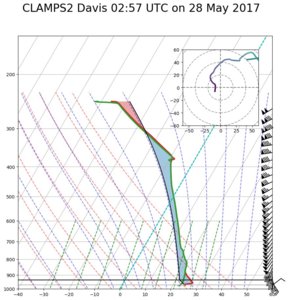An OU grad student and researcher for the CLAMPS field experiment was sending up balloons every few hours leading up to initiation in south-central Oklahoma on Saturday's chase. During the evening, the group sent a rawinsonde directly into the updraft of the intense storms down there, and the result was this:

Note the deep saturation and generally moist-adiabatic lapse rates from 900-400 mb. Also note the rather extreme horizontal winds and hodograph shape. You can find model soundings that look a lot like this if you pick a location that has received high precipitation in the most recent slot of time.
Use this as a reference for knowing when you're looking at a forecast sounding that looks extreme...if the location of the sounding has high precip or simulated reflectivity in it, then you know it's going through the updraft of a modeled storm and does not represent the large-scale environment in which the storm exists.
Final treat: measured ascent rates of this balloon ranged from 28-46 m/s. 46 m/s (~102 mph) is probably within a few m/s of the fastest upward velocities you will ever see. The caveat to this is that the balloon itself has a background upward motion (because it has to if you want it to ascend and measure the atmosphere) that is mixed in with the measured ascent rate. I think the typical value of ascent (near the ground at least) is about 5 m/s, but it depends on the size of the balloon and the payload. These might have been smaller balloons than the ones NWS offices send up twice a day. In that case the background ascent rate was probably lower than 5 m/s. Maybe 3 or 4.

Note the deep saturation and generally moist-adiabatic lapse rates from 900-400 mb. Also note the rather extreme horizontal winds and hodograph shape. You can find model soundings that look a lot like this if you pick a location that has received high precipitation in the most recent slot of time.
Use this as a reference for knowing when you're looking at a forecast sounding that looks extreme...if the location of the sounding has high precip or simulated reflectivity in it, then you know it's going through the updraft of a modeled storm and does not represent the large-scale environment in which the storm exists.
Final treat: measured ascent rates of this balloon ranged from 28-46 m/s. 46 m/s (~102 mph) is probably within a few m/s of the fastest upward velocities you will ever see. The caveat to this is that the balloon itself has a background upward motion (because it has to if you want it to ascend and measure the atmosphere) that is mixed in with the measured ascent rate. I think the typical value of ascent (near the ground at least) is about 5 m/s, but it depends on the size of the balloon and the payload. These might have been smaller balloons than the ones NWS offices send up twice a day. In that case the background ascent rate was probably lower than 5 m/s. Maybe 3 or 4.
